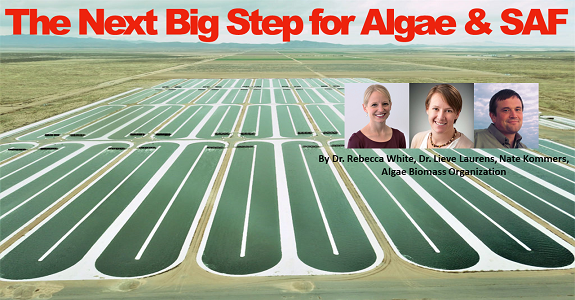The Next Big Step for Algae and Sustainable Aviation Fuels

By Dr. Rebecca White, Dr. Lieve Laurens, Nate Kommers, Algae Biomass Organization
Special to The Digest
Among the dozens of policy innovations that Congress must consider in climate change legislation is a tool that could help trigger the next stage in decarbonizing one of the most significant industries in the world: aviation.
The provision is a tax credit that would give producers of sustainable aviation fuels, known as SAFs, a level playing field when it comes to competing with traditional fuels. It would mark a new era in a long effort to address the 2% of all greenhouse gases that come from aviation, and become a gateway to building a sustainable fuel infrastructure that works with the world’s existing fleets. SAFs take advantage of a variety of sustainable fuel feedstocks such as waste oil, tallow, agricultural crops, or microorganisms like yeasts and algae.
SAFs are proven to work, but have also been held back
The technical principles to make these fuels have been around for almost as long as the technologies that have made electric cars, or wind and solar energy successful. Yet despite a long list of advantages that include lower carbon intensities, lower particulate levels and even better performance potentials, SAFs make up less than 1% of aviation fuel used today. So, what’s holding things back?
It doesn’t seem to be a lack of vocal support. The global aviation industry has announced a goal to be carbon neutral by 2050. President Biden has pledged to produce 3 billion gallons[1] of sustainable fuel and reduce aviation emissions by 20% by the year 2030. And U.S. airlines have backed up those impressive commitments with support of their own, adopting targets for sustainable aviation fuels across the board, and operating flights with SAFs[2].
It isn’t a technology problem either, as a dedicated community of engineers and scientists have refined SAF production in countless ways. Most SAFs are made with biomass, often crops like soy or microorganisms like yeasts or algae. For each of these there has been ample success. Just last fall, Honeywell announced[3] that its refining process was used to successfully supply commercial flights with SAFs derived from microalgae.
In fact, the story of algae-based SAFs offers an interesting case study in the kind of obstacles that have delayed the decarbonization of aviation. A decade ago, there was a frenzy of interest in algae for fuel that stirred up investments and lofty promises by a number of startups – all based on very exciting, but also preliminary, technical analysis of how efficiently algae could be used to turn sunlight, water and fertilizer into fuel. Unfortunately, those promises gave way to delays, then frustration, and finally outright skepticism on whether the fuels would ever work.
Yet over the past ten years the algae industry has quietly been overcoming the hurdles. There has been no single breakthrough to make headlines. Instead, dozens of new innovations across the board have improved efficiencies, streamlined processing, and boosted production possibilities.
This iterative technical progress is showing real results. As part of the Pacific Northwest National Laboratory’s DISCOVR R&D consortium, the cost estimates of producing one ton of algae have been brought down to approximately $600 per ton when viewed on an nth-plant commercial-scale basis[4]. Global Algae Innovations, a company that been part of some of the leading collaborative research efforts, estimates production costs of approximately $800 per ton[5]. These figures are several times better than what was possible 10 years ago.
To put it another way: If algae can be scaled-up to commercial production costs in this range, it would translate into an aviation fuel price approaching economic viability, while simultaneously reducing carbon emissions. That is more than enough incentive to compete with petroleum fuels, especially when paired with existing policy support or consideration of coproduct opportunities, as well as commitments from the international community to decarbonize aviation.
One of the more significant impediments to SAFs is supplying the needed volumes of the fuels to make a difference in the annual blending capacity. This has been a major hurdle associated with novel and innovative SAF production routes. While many pathways are approved and recognized as qualifying as sustainable[6] for the production of renewable fuel, the scalability of the feedstocks to reach the needed targets of national scale fuel output (i.e. 35 billions of gallons of SAF by 2050[7]) often does not present a feasible output.
The emergence of algae as a highly productive innovative agricultural crop offers an opportunity of scalability and carbon efficiency that is poised to make a dent. On the basis of productivity, the current achieved yields from open, large-scale, algae ponds are at least three-fold higher than terrestrial crops, producing approximately 30 tons per acre of algal biomass, while corn typically yields approximately 7-8 tons per acre. Microalgae can take you from soy’s minimal yield of <0.4 tons per acre of SAF precursors to 10 tons or more, requiring orders of magnitude less of a land footprint. This is a great outcome for greenhouse gas impacts!
Additionally, algae biomass is well-suited to be processed in existing refining infrastructure. Algae biomass comprises, conservatively, about one fifth fatty acids and derivative oils, whose molecular composition directly or combined with other feedstocks is ideally suited to enter into an existing refinery’s hydrotreater, and produce blend-ready SAF following a hydrotreated esters and fatty acid (HEFA) pathway that has been ASTM certified (D7566). Algae oils are generally ideally positioned to contribute to a HEFA-SAF thanks to an attractive carbon chain length profile. However, to make a substantial contribution to SAFs, the algae oil content in algae biomass would need to exceed the currently demonstrated levels in large-scale cultivation systems.
Beyond pure yield, the biomass composition of algae feedstocks, with over 50% of its weight as carbon, becomes an attractive feedstock for the production of fatty acid and ethanol-derived SAFs. The high carbon content is often leveraged as an effective carbon capture strategy. The biomass elemental composition translates to approximately two tons of CO2 that are stored for every one ton of biomass produced, which is more efficient than the just , such as possible future producers tax credits, would significantly reduce the cost-burden and stimulate the needed large scale biorefinery deployments.
Based on a recent resource and sustainability assessment of nation-wide algae production potential[8], projections estimate that over 20 billion gallons of SAFs could be produced across a collection of >1,000 large algae farms, considering highly productive agricultural deployment across non-arable land. Even modest 100 acre farms are able to present opportunities for e.g. 3,000 tons of biomass, or the equivalent of over 120,000 gallons (or 3,000 barrels) of SAF, sustainably and photosynthetically produced. This clearly indicates the significant potential for algae to contribute to the nationwide quest for SAFs, and provides support for deployment of algae technologies. Additionally, recent waste water treatment reports calculates that with available waste water resources it is possible to achieve 4-6 million tons of algae biomass per year, equivalent to 300-500 million gallons of SAF[9],
Existing national-scale policy credits, such as the RIN credits under the Renewable Fuels Standard, can be used to support the necessary rapid expansion of deployment of algae-based technologies. Current legislation includes an up to $3/GGE credit if the renewable liquid SAF can be produced with an at least 50% reduction in GHG emissions relative to its petroleum-derived SAF counterparts[10]. The D5 RINs are already accessible for photosynthetically produced fatty acids from algae. Not only does fatty acid-derived SAF qualify for RIN credits, the ASTM Aviation Fuel Standard has long specified and approved bioderived components, such as fatty acids (in a HEFA pathway) from feedstocks including photosynthetic and other algae[11].
The next stage of SAFs
So why hasn’t the support and technical progress translated into more sustainable skies? It comes down to one final hurdle: scale.
Current SAF production facilities are tiny compared to the economies of scale available to fossil fuels. Unless we can achieve meaningful production, the goals so many have set for a low carbon aviation industry will be impossible to meet.
There are some signs of serious investments being made in SAF production. Neste, a global leader in biofuel production, recently announced a new capacity of up to half a million tons of sustainable aviation fuels[12]. This is equivalent to about 165 million gallons. Some estimates indicate that from a feedstock perspective, there is enough raw material to fuel all of aviation by 2030, but production is held back by the scale of new technologies and plants that can run on less constrained feedstocks[13]. And if we look at the number of SAF production plants around the globe that have been announced or that are already in production we can see production approaching 3.5 million metric tons by 2025[14]. That’s equivalent to more than a billion gallons, but still only halfway to the Biden administration’s goals for the United States alone by 2030. We are going in the right direction, but we need to pick up the pace.
Every viable feedstock will need more physical infrastructure that can transform biomass into SAFs. These are capital heavy endeavors, and many of them may take a long time for a meaningful ROI to materialize. This is why the tax credit that had been included in the Build Back Better legislation, and other policy supports targeting commercial production, is so important.
A SAF tax credit will give a sense of stability to producers and investors, making it much easier to commit to building large-scale facilities. Today we see a marketplace filled with electric cars, renewable electricity, and low-carbon liquid fuels for cars and trucks that was turbocharged when similar tax credits provided the lubricant these technologies needed to show capital markets that they can be viable alternatives.
Tax policy doesn’t have to act alone, either. Other effective programs include public-private partnerships that can demonstrate large scale production, essentially proving to potential investors what models will work.
If we give SAFs the boost they need we will be overcoming the final barrier that so many new technologies face at this stage of development between proving viability and getting to a scale that can properly enter the market.
In the case of SAFs, getting from proving technical viability to true commercial scale will likely have compounding benefits. A larger base of global algae production will give this relatively new feedstock a chance to succeed in other markets that can benefit from low-carbon feedstocks: more sustainable food production, biomaterials that can replace petroleum-based plastics or chemicals, and services such as water treatment.
The commitment we need today from policy leaders is one that aims SAFs toward commercial scale. It will be followed by a remarkable transition to cleaner skies, a new sector of economic growth, and a message to every other industry wrestling with decarbonization: It can be done.
Notes:
[1] https://www.whitehouse.gov/briefing-room/statements-releases/2021/09/09/fact-sheet-biden-administration-advances-the-future-of-sustainable-fuels-in-american-aviation/
[2] https://www.businessinsider.com/united-operates-passenger-flight-with-100-sustainable-aviation-fuel-2021-12
[3] http://biomassmagazine.com/articles/18484/honeywell-technology-enables-jet-flights-with-saf-from-algal-oil
[4] https://www.energy.gov/sites/default/files/2021-04/beto-06-peer-review-2021-algae-huesemann.pdf
[5] Pinowska, A. & Hazlebeck, D. (2021) International Society of Applied Phycology, Special Session 04: “Next Frontiers of Algae Cultivation for Food and Fuel” and Hazlebeck, D. (2020), ABO summit Biofoundary plenary presentation Sept 2020
[6] https://www.epa.gov/renewable-fuel-standard-program/approved-pathways-renewable-fuel
[7] https://www.whitehouse.gov/briefing-room/statements-releases/2021/09/09/fact-sheet-biden-administration-advances-the-future-of-sustainable-fuels-in-american-aviation/
[8] https://www.nrel.gov/docs/fy18osti/70715.pdf
[9] https://www.nrel.gov/docs/fy21osti/75237.pdf
[10] https://www.epa.gov/fuels-registration-reporting-and-compliance-help/rin-trades-and-price-information
[11] https://newsroom.astm.org/astm-aviation-fuel-standard-now-specifies-bioderived-components
[12] https://www.neste.com/releases-and-news/renewable-solutions/neste-enable-production-500000-tonsa-sustainable-aviation-fuel-its-rotterdam-renewable-products
[13] https://www3.weforum.org/docs/WEF_Clean_Skies_Tomorrow_SAF_Analytics_2020.pdf
[14] https://aviationbenefits.org/media/167187/w2050_full.pdf
Category: Thought Leadership, Top Stories















